How to water a pumpkin?
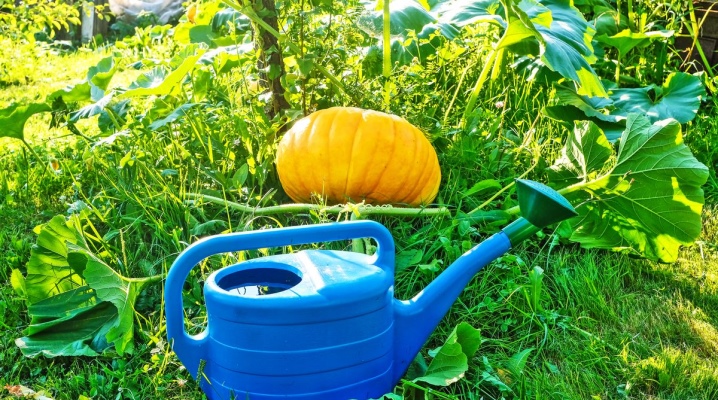
Growing pumpkin with the right approach can give a lot of fiber-rich plant tissue useful for the human body. A pumpkin harvest can last for almost a year: from the day of harvest to the next planting.
General rules
The pumpkin, like other species of the pumpkin family, does not tolerate careless maintenance. Violation of the timing and deviation from the time of watering will lead to the fact that the crop will be poor - or it may not be at all. Despite the fact that all pumpkin varieties, after the appearance of large shoots, enter the stage of active growth and begin to grow chaotically, capturing the rest of the territory and letting out new roots there in search of excess moisture, this plant is not able to survive during a period of drought, prolonged (by the number of days) heat ... A pumpkin needs sun - but it also needs a lot of moisture.
This plant cannot coexist with many other species: cultivated, fundamentally different from it. For example, if you plant currant bushes nearby, grow wheat, etc., the rapidly growing pumpkin “vine” with its “mustache”, like a vine, will strangle the “competitor for a place in the sun”. In the place where the branch-leaf knot touched the ground, the pumpkin branches immediately sprout new roots, as if fixing themselves in the habitable territory. The pumpkin has a well-developed migration from place to place: the parental shoot will already wither away, and the branches that have grown from it, catching new roots on the ground, as if nothing had happened, grow and develop further.
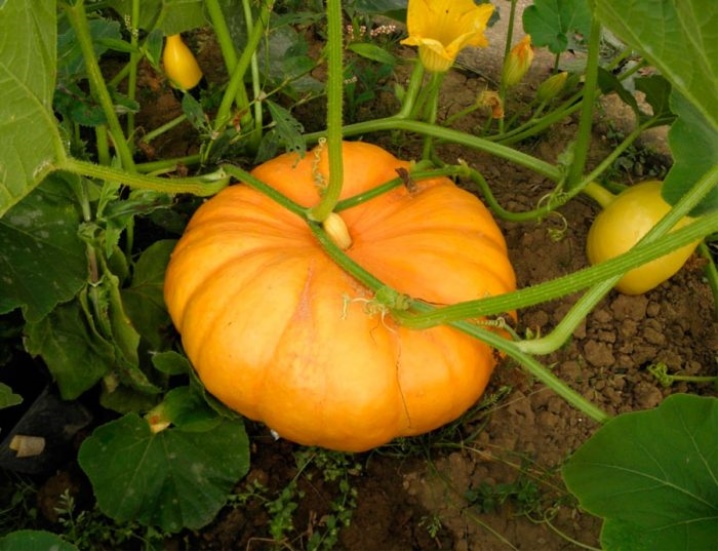
When watering a pumpkin, you cannot pour water randomly - you will lose the account. Some areas (individual bushes or their branches) will remain under-watered - or the soil will be waterlogged. Insufficiently watered overgrowths of pumpkin will form undergrown fruits that resemble pomegranates or apples in size, possibly small melons. All pumpkin varieties - both early and late-ripening - ideally produce fruits weighing at least several kilograms. Their weight and dimensions are close to the dimensions and mass of medium and large-sized watermelons. And although small fruits, if allowed to ripen according to all the rules, can turn out to be no less tasty than their larger counterparts, this feature of the pumpkin is an extreme, into which it is irrational to hit.
It is forbidden to direct a tight stream of water with force, eroding the soil. Drops of earthen slurry, scattering in all directions, form dirty streaks, due to which a fungus, mold or duckweed forms in the place of their untimely washing away. This leads to damage to leaves and stems, regardless of the age (in days) of the shoots. The diseased plant discards the newly formed ovaries. Flowers, not yet pollinated, wither without waiting for pollination.
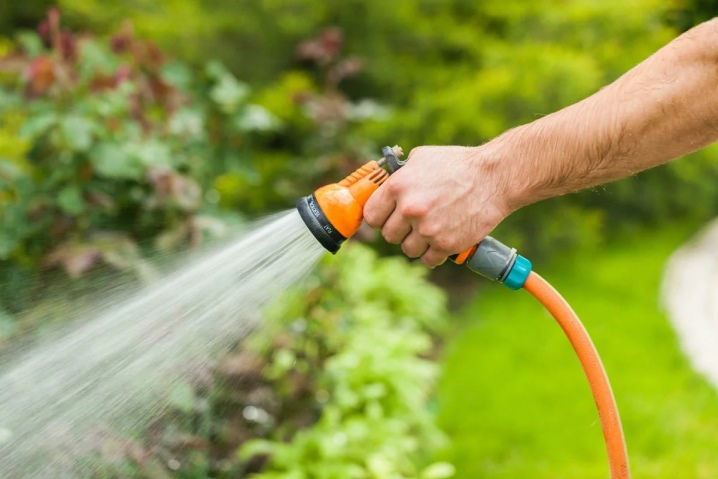
It is also not recommended to turn on a powerful, strong pressure during watering.
Sections of the garden, delimited for water retention, overflowing, will gradually wash out the stem circles - the latter will have to be formed anew, after waiting until the wet earth dries up and becomes loose again. Keep track of how much water is leaving. If you do not want to wait until the grip circles are filled, use a small pressure by opening the tap a little. Set up a jet that will fill the near-foot zone - but the latter will not overflow with water, since the water itself has time to seep into the ground.
Long beds, along which pumpkin seeds were planted at some distance from each other, can also be watered through grooves drawn from one stem circle to another.What does not fit into the first circle will flow into the second, without merging either to the right or to the left, and so on until the last circle. With insufficient water pressure, it does not reach the last pumpkin bush, but manages to absorb into the areas closest to the location of the end of the hose. Single bushes, spaced from each other, say, a meter, it also makes sense to combine for watering in small "trenches"; in this case, the excessive consumption of water will be significant.
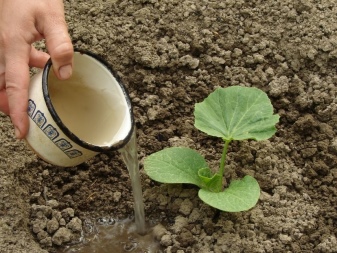
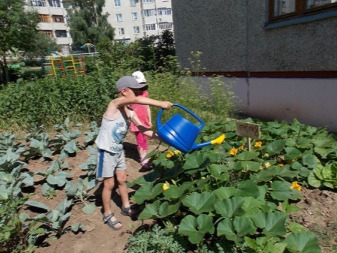
What should be the water?
The best - the most life-giving - water has properties that truly stimulate the growth of all types of vegetation. This is rain, given free of charge to summer residents and gardeners by nature. It is not worth relying on rain in full: in April and May, it is usually present more often than in the summer months. Nature arranged it so that mostly spring is the period of pollination of flowers and the rapid growth of the formed fruit... For 20-25 days, a green pumpkin the size of a cherry berry can approach the size of a full-fledged watermelon or melon. Quite often anomalies occur in spring and summer - either a real season of heavy rains, or a drought that has not been seen in recent decades. If rainwater is not collected in a special pool, extra-large (up to a ton) containers and containers or in an old bathtub, then the water supply comes to the rescue.
Tap water, despite cleaning, settling, disinfection, has chlorine impurities. Chlorination effectively kills 99% of bacteria; Chlorine present in such water (together with nitrogen and oxygen from the air) is poisonous to all living things. If you often drink such water, a person will provoke malfunctions in the immune system, shatter the functioning of the digestive organs, etc. Once in plants - in the same pumpkin, chlorine is incorporated into the grown and ripening fruits, forming organochlorine compounds that are not useful for the human body and animals. To remove chlorine, let the water sit in warm or hot conditions.

Sulfur compounds (hydrogen sulfide) are removed from well water in the same way: hydrogen sulfide adds oxygen from the water and turns into sulfurous acid. As for iron, water-soluble nitrous oxide (it is colorless) is additionally oxidized by oxygen dissolved in water to insoluble rust - and falls to the bottom, settles on the walls of the container. Carefully spending water, trying not to stir up the bottom sediments, achieve relatively clean watering of pumpkins and other garden crops. However, having got to the beds together with water, sulfur-containing and ferruginous compounds react with minerals and soil organic matter, forming a white coating of salt after a dozen or more irrigation sessions. That's why it is not recommended to use unsteady water - it is even better to purify it with a filter.
The so-called. living water (catholyte) - it is enriched with cations (positive ions) and has an alkaline reaction.
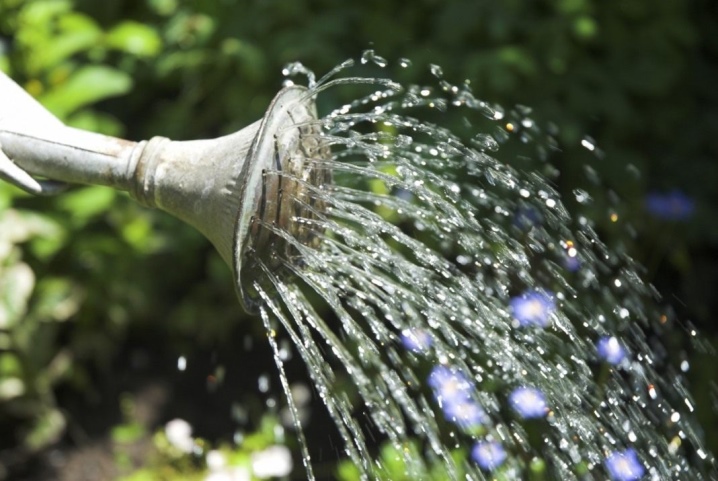
With its help, it is possible to achieve accelerated germination of seedlings of seedlings - immediately before planting in open ground. Dead water (with negative ions), sprayed after watering on adult plants - in order to inhibit the germination of spores into mold, the development of fungus and putrefactive processes on stems and leaves - not used for watering. Any growth when watered with dead water will immediately stop, and the plant will begin to ache. You can get live and dead water using an electrolyzer with stainless electrodes. But for this it must be purified: defended and filtered. The method has not become widespread due to the laboriousness of the process and unnecessary loss of time.
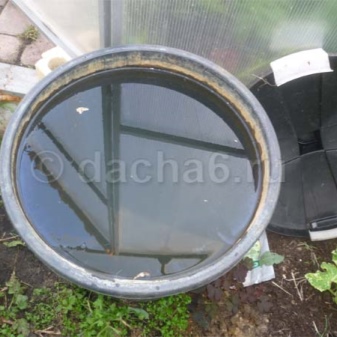
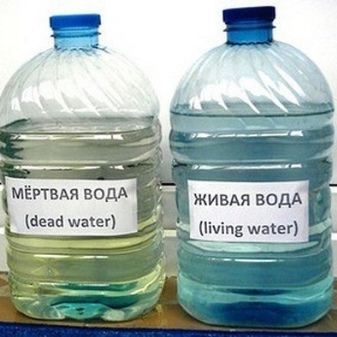
How often to water?
Seedlings (seedlings) are watered with a small amount of water, but regularly, every day. In hot weather, plants should be placed, for example, under a piece of cellular polycarbonate. As a result, diffused sunlight will not scorch the pumpkin plantings.This option is more and more relevant for the southern regions of Russia, where the temperature in the sun - especially at the end of June and in July - reaches 45, and in the shade this figure exceeds 35 degrees. Direct sunlight in the middle of summer, despite the most abundant and regular watering, can cause some of the leaves to dry out. In general, a pumpkin patch is watered once a day - abundantly, the best effect is achieved precisely with evening watering.
An adult bush consumes 10 or more liters of water - especially in the stage of active fruit growth.
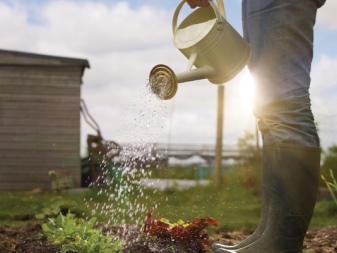
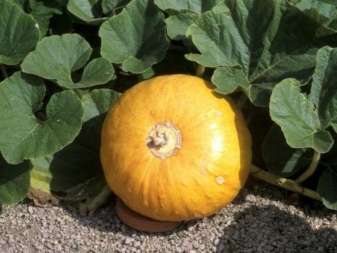
During flowering
The amount of water in constant clear weather does not affect flowering so much. The main thing is to pour water gently under the root of each bush, refusing to sprinkle for this time. The fact is that "shower" watering disperses bees and bumblebees pollinating flowers, and the lifespan of one flower is a maximum of three days, after which it withers without pollinating. If there are no bees (and other insects), then cross-pollination by the wind is possible. The pollen nailed down by the water will not get on the pistils of the flowers - they should remain as dry as possible. The branches of pumpkin bushes should receive enough moisture so that after pollination and fertilization, the ovary immediately begins to gain weight, turning into a large fruit.
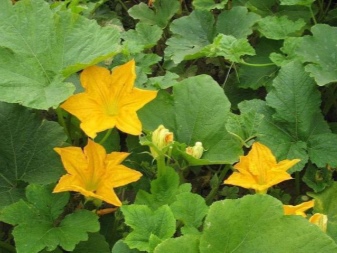
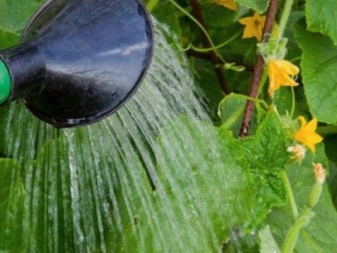
During the period of setting and pouring fruits
Detection of formed ovaries is a signal to increase the amount of water for each bush up to 10 liters per day. Having counted several ovaries on one bush, urgently cut off the processes extending in all directions and get rid of excess flowers. This is done so that the flow of water does not become uncontrolled, and new flowers (and ovaries), the processes of the aerial part do not turn into an impenetrable jungle and do not take away nutrients from the fruits, which have already set up and set off into rapid growth. If the pumpkin bushes are not trimmed, there will either be a lot of small pumpkin fruits, or some will rot - they do not get enough sunlight due to the large amount of tops blocking their access to the sun.
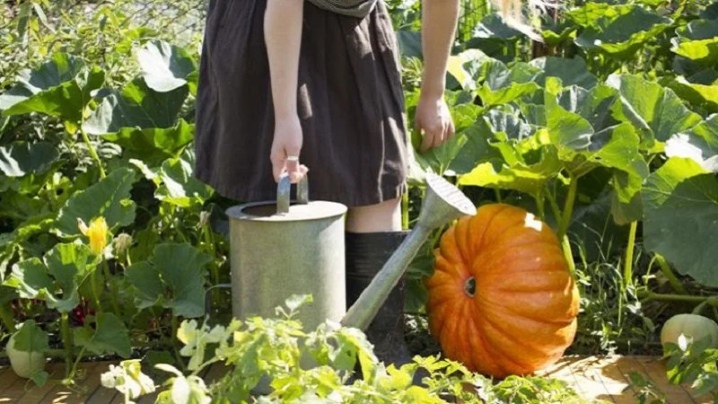
It is permissible to calculate the frequency of watering a pumpkin by the number of kilograms of future fruits of the same bush in terms of water - without taking into account a small supply in case of scorching heat or a temporary lack of access to water. For example, if one bush yields 5 fruits of 10 kg each, then the total number of liters per bush is calculated in two stages.
- Pumpkin is 90% water, we get 50 kg and add another 10% - 55 liters of water will be required per bush.
- Taking into account the reserve (for reliability), we bring the number of liters of water to 60 - if the pumpkin grows in greenhouse conditions and under artificial lighting in winter. In summer, in the open field, we double or triple this figure - 120 or 180 liters, depending on the intensity of the heat and heat. At +42 in the sun and +35 in the shade, water evaporation from the soil surface goes up to several times faster than in winter in a greenhouse at +20.
The resulting amount of water - 180 liters - is divided by the number of days during which the pumpkin grows rapidly. For example, if the fruits gained their original sizes in 36 days, then for each pumpkin bush, in this case, it takes 5 liters. The calculation is valid for submerged drip irrigation, when water is supplied at a depth of 20 cm directly to the roots.
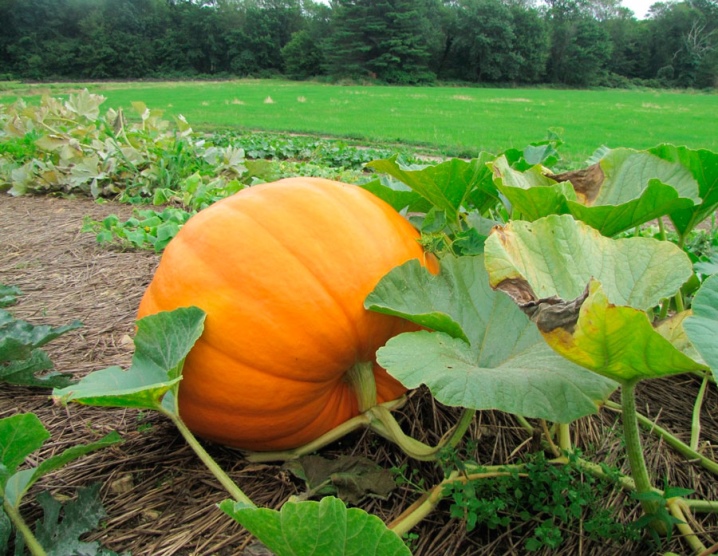
When to stop watering?
It is recommended to stop watering the pumpkin when the fruits have gained their bulk. It means that the frequency and intensity of irrigation are reduced several times... The fruits do not grow indefinitely, which means that they have entered the ripening stage, which can take 2-3 months, depending on the pumpkin variety.
For example, if earlier the root of a bush sucked in 5 liters of water, at the stage of final ripening one liter is enough for it. If you continue watering at the ripening stage in the same rhythm, then the pumpkin will not gain its characteristic taste. Then its structure will be more watery than nature and breeders intended.
People who have tasted the pumpkin, the bush of which was filled with water until the onset of the "golden autumn", will certainly complain about the tasteless fruits.
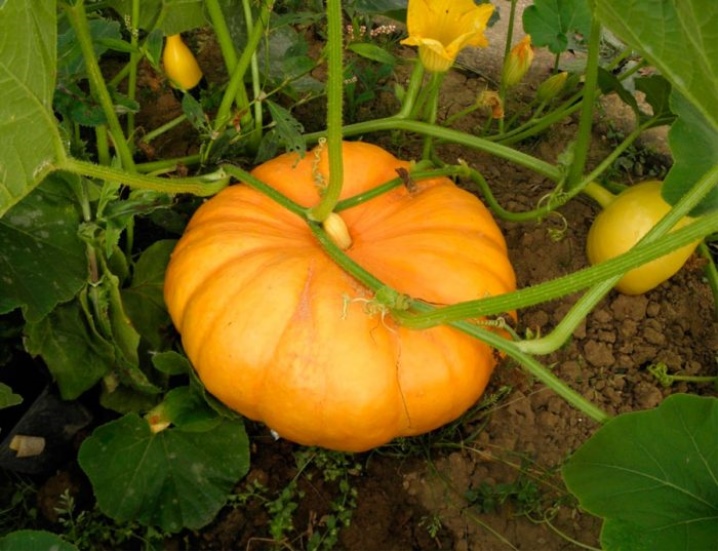
For information on how to water a pumpkin, see the video.













The comment was sent successfully.